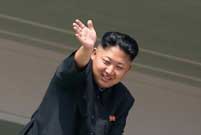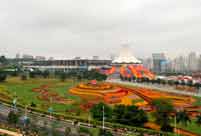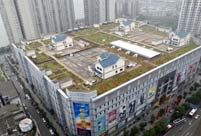For many Chinese, the first impression of Samarkand — a city with a 2,500-year history and a major stop along the ancient Silk Road — are the camel bells echoing in the mountains and the wisp of smoke rising from the desert.
President Xi Jinping arrived in the city on Tuesday to pay tribute to the ancient Central Asian civilization.
This is the only sightseeing trip he has planned for his 11-day, five-country tour. Uzbek President Islam Karimov, who accompanied Xi during the visit to his hometown, introduced Xi to details about the ancient Silk Road.
Karimov especially mentioned to Xi that Xi'an, capital of Shaanxi, Xi's home province, was the starting point of the ancient Silk Road.
Xi said he got a sense of "being poetic".
"This gives us a special feeling. We are far away in distance, but we are also so near to each other in our soul. It is just like time travel," Xi said.
Samarkand, a major transit point on the ancient Silk Road and a gateway for China to Central Asia, has made important contributions to the exchanges between Eastern and Western civilizations. The ancient market at Registan Square in the city has witnessed many envoys, caravans, travelers, scholars and artisans traveling between East and West.
Grand buildings dating back to the 14th and 15th centuries stand testament to the prosperity and rich history that the city used to boast as the ancient capital of the all-conquering Timurid Empire.
And any Chinese visiting the city cannot help but marvel at the close links between China and the Central Asian region, bound in history. More than 2,100 years ago, during China's Western Han Dynasty (206 BC-AD 24), imperial envoy Zhang Qian was sent to Central Asia twice to open up China to the world of commercial trade and cultural communication.
His journeys opened the door to friendly contacts between China and Central Asian countries as well as the transcontinental Silk Road linking East and West, Asia and Europe.
The route linked traders, merchants, pilgrims, monks, nomads and dwellers from China to the Mediterranean Sea.
It got its name from the lucrative Chinese silk trade carried out along its length of more than 7,000 km. It was important for the development of Chinese civilization.
As ties between China and Central Asia evolve, the Chinese president has proposed building an economic belt along the Silk Road. It is the new strategy of China's new leadership in mapping out its Central Asia policy.
The economic belt, proposed by Xi last week during a key policy speech, could revitalize the ancient prosperous route. The belt is inhabited by nearly 3 billion people and represents the biggest market in the world with unparalleled potential. If realized, the economic belt will greatly benefit the people of all countries along the route.
But it won't be an easy task, and much work needs to be done.
Building transportation connections remains a challenge. The Shanghai Cooperation Organization, comprising China, Russia and Central Asian nations, is mulling over a major transportation route that would connect the Pacific and the Baltic Sea. This route connects East Asia, West Asia and South Asia to facilitate economic development and travel in the region.
But before the work is done, transportation will continue to be a problem. Trains from China have difficulty traveling on railways once they enter nations that were once part of the Soviet Union.
Airlines are not fully developed, either.
A friend of mine, who has to fly by herself to cover the trip, said there is only one flight between Uzbekistan and Kyrgyzstan every two days.
 DPRK holds military parade to mark 65th founding anniv.
DPRK holds military parade to mark 65th founding anniv. Highlights of MAKS 2013 Int'l Aviation and Space Show
Highlights of MAKS 2013 Int'l Aviation and Space Show  10th China-ASEAN Expo opens in Nanning
10th China-ASEAN Expo opens in Nanning Eagle Boy takes to sky to break another record
Eagle Boy takes to sky to break another record 12-year-old boy becomes pillar of the family
12-year-old boy becomes pillar of the family Eye-gouged boy receives blind rehabilitation in Shanxi
Eye-gouged boy receives blind rehabilitation in Shanxi Top 10 naked hotels in the world
Top 10 naked hotels in the world The most gorgeous Chinese women in the eyes of foreigners
The most gorgeous Chinese women in the eyes of foreigners A collection of bizarre rooftop buildings around China
A collection of bizarre rooftop buildings around China Residences of the royal house of Savoy
Residences of the royal house of Savoy China's frigate 'Bengbu'in fire training
China's frigate 'Bengbu'in fire training Fresh students 'forced' to register in university independently
Fresh students 'forced' to register in university independently 2013 Taiwan Int'l Tourism Expo kicks off in Taipei
2013 Taiwan Int'l Tourism Expo kicks off in Taipei Photo story: Take a gap year
Photo story: Take a gap year Nokia's Global Headquarters: visiting a declining empire
Nokia's Global Headquarters: visiting a declining empireDay|Week|Month